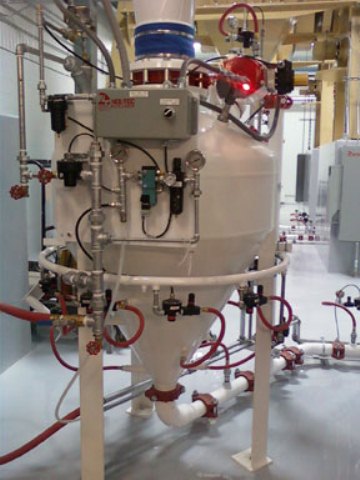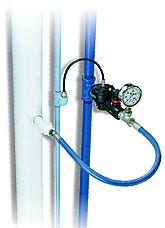Details Matter When Considering Dense-Phase Conveying
January 4, 2012

Dense-phase pneumatic conveying offers many advantages for bulk materials handling. It is the typical first choice for moving abrasive materials, but is also used with great success to convey all kinds of agglomerated, friable, heavy, or blended bulk materials. However, to avail yourself of these advantages, there are certain areas of conveying system design that should be given due consideration to ensure that dense-phase conveying is your best choice. The details can make or break a successful system installation.
First, let’s talk about the advantages that dense-phase conveying offers. Dense-phase conveying utilizes a relatively low-velocity motive gas, relying on a high-pressure differential (either positive or negative) to move your bulk materials. Low velocity results in a gentle transfer, with materials moving with less wear and impact. This makes dense-phase conveying ideal for most abrasive, fragile, friable, or even mixed-batch materials. You’ll experience reduced product breakage, meaning less product waste. Material segregation is also minimized, thus reducing potential downstream process issues.
Another advantage dense-phase conveying offers is less component wear as compared to dilute-phase design. Lower motive gas velocity means components don’t take such a beating from the materials being transferred. Think of how a sand blaster works. Abrasive material is shot at a surface at very high velocity in a dilute manner. It certainly cleans the surface, but repeated blasting will just as surely damage that surface. When materials are moved at lower, dense-phase velocity, components last longer, lowering maintenance costs, and decreasing down time.
Because of the material transfer velocity reduction and cost savings mentioned above, dense-phase conveying can translate into real cost savings for your business. So there are real advantages to make the move to a dense-phase conveying system. However, when making a decision about which type of conveying system you should choose, there are a number of areas that require special consideration to be sure you select the best system to meet your needs.
One area of consideration is fluidization. Dense-phase pneumatic conveying generally relies on the ability to fluidize solids – make the materials flow like a liquid when a motive gas is introduced. However, not all materials will fluidize. Some fine granules, such as calcium carbonate, compact under the pressure that is required to move them. Your system can become a very efficient plug-maker. Some mixtures that consist of both fine and coarse particles that are of vastly differing sizes or irregular shapes will compact, rather than flow. If the material segregates, and the coarse particles concentrate in the line, the fine granules will simply fill in the gaps and again, make a very effective plug.
On the other hand, not all materials need to fluidize in order to move efficiently through a dense-phase conveying system. For example, medium size granules can be conveyed without fluidization, if the system’s length and pressure are calculated correctly. These calculations require experience and testing to be successful.
|
Air injectors introduce pulses of air into transporter to ensure fluidization of materials and smoother flow. |
Another area to consider is whether there is a need for additional conveying line air injectors to be incorporated into the conveying system. Some systems will function more efficiently with the introduction of air periodically along the conveying line. In the fluidization examples discussed above, strategic addition of pulses of air can help ensure that bulk materials move properly throughout the entire pneumatic conveying system at minimum velocity.
Air injection can also minimize bridging of fine powders in the cone of the transporter. Without the use of transporter cone aeration, powder can bridge above the transporter cone outlet and stop feeding into the line. Properly placed injectors will fluidize the powder in the transporter cone, keeping the flow into the line consistent. Determining the location and pressure of those air injections – whether in the transporter or along the conveying line – is crucial to a system that flows smoothly and doesn’t plug. Additionally, with the use of strategic air injection, overall system gas consumption will be reduced for increased efficiency. System reliability is also greatly increased. Along with the correct calculations of motive gas volume and conveying pressure, air injector locations must be positioned to best enhance materials flow.
There are several system design elements to be considered, the first of which pertains to the physical characteristics of the product being handled. Bulk density, abrasiveness, friability, particle size/distribution/shape, moisture content, temperature, and static charge all are factors considered. The rate, length, and pipeline routing configuration of a pneumatic conveying system will impact overall system design.
As a general rule, the line diameter of a dense-phase system will be smaller than that of a comparably sized dilute-phase system. The smaller pipeline will reduce the space and cost required for installation. This benefit is especially noteworthy when the line routing is long and includes many bends.
In short, dense-phase conveying offers a number of advantages – but requires specialized expertise to ensure it is the best choice for your needs. Each bulk material handling system is unique and merits a specifically engineered solution for best results. Once it is determined that dense-phase conveying is the right choice, there are system design elements that require experience to develop for highest effectiveness. But even the most experienced dense phase system designer will recommend that laboratory testing be conducted to verify that his design assumptions are correct. A reputable dense-phase system supplier will recommend and offer these testing services.
In today’s economic environment, the temptation might be to purchase individual components to slot into your current manufacturing processes. It may seem like a cost-effective decision. The idea of working with an expert to custom design a complete system may seem like a larger investment than necessary. However, when it comes to the long-term viability and maintenance of your conveying process, a designed system offers you more value over time. Dense-phase conveying, properly customized to your needs, can reduce your long-term maintenance costs and system downtime. But great attention must be paid to the specifics. Getting the details right can mean the difference between profit and loss in your business.
Mike Weyandt is the corporate sales manager of Nol-Tec Systems Inc. (Lino Lakes, MN), a supplier of pneumatic conveying systems and related equipment. He has worked in the bulk materials handling industry since 1979, concentrating on pneumatic conveyor design. He can be reached at [email protected] or 651-780-8600 ext. 244. For more information, visit www.nol-tec.com.
You May Also Like



